Effect of Nitrogen Fertilization on Triticale Growth Under Rainfed and Supplemental Irrigation Systems
Mudhafar Abu-Altemen and Mustapha Haidar*
Department of Agriculture, Faculty of Agriculture and Food Sciences, American University of Beirut, Lebanon
Submission: December 14, 2023; Published: December 20, 2023
*Corresponding author: Mustapha Haidar, Department of Agriculture, Faculty of Agriculture and Food Sciences, American University of Beirut, Lebanon
How to cite this article: Mudhafar Abu-A, Mustapha H. Effect of Nitrogen Fertilization on Triticale Growth Under Rainfed and Supplemental Irrigation Systems. Agri Res & Tech: Open Access J. 2023; 28 (1): 556394. DOI: 10.19080/ARTOAJ.2023.28.556394
Abstract
Two adjacent field studies were conducted in the fall of 2020-2021 at the Advancing Research Enabling Communities Center (AREC) at the American University of Beirut, Lebanon to examine the effect of various rates of nitrogen fertilizer on the growth and yield of triticale under rainfed and supplementary irrigation. Treatments were NPK, and various rates of nitrogen fertilizer. Results showed that supplementary irrigation alone significantly increased crop height, shoot dry weight, grain starch content, and grain yield, compared to the rain-fed regardless of nitrogen applications. The average grain yield of triticale under supplementary irrigation was 5.8 tons/ha while it was 4.9 tons/ha under rainfed conditions. A higher yield was obtained under supplementary irrigation than in the rainfed system regardless of the nitrogen application. Nitrogen at all tested rates increased the grain area of triticale under supplementary irrigation, compared to the same treatments under rainfed conditions. In conclusion, supplementary irrigation alone may give higher biomass and yield quantity and better grain quality than nitrogen fertilizer under rainfed conditions.
Keywords: Triticale; Nitrogen Fertilizer; Supplementary Irrigation; Rainfed; Drought Stress
Abbreviations: Triticale; Nitrogen Fertilizer; Supplementary Irrigation; Rainfed; Drought Stress
Introduction
Triticale (x Triticosecale Wittmack) is a man-made hybrid, a cross of wheat (Triticum spp.) and rye (Secale cereale L). It combines favorable traits from both crops like growth and vigor, cold tolerance, and high protein [1]). It has greater drought, saline, and disease resistance than wheat and rye. Both forage and grain types of triticale are grown, but it is primarily used as feed for animals [2]. Algeria and Tunisia are the main triticale producers in the MENA region [3]. Water and nitrogen are the most limited resources for grain production in the MENA region. Both resources are overused in grain production, and they are no longer sustainable. The Beqaa plain in Lebanon is the leading county for rainfed cereal grain production but it is facing various challenges among them are the lack of sustainable water resources, a limited amount of precipitation (<500 mm/year), and the high exploitation of groundwater to an alarming decline of 15-20 meters in groundwater levels. Another critical challenge is the threat to water quality from the excessive use of agrochemicals such as nitrogen. Many studies showed that proper application of nitrogen is an important indicator that affects triticale growth and development. The objective of this study was to test the impact of various rates of nitrogen fertilizer on triticale growth under supplementary and rainfed conditions.
Materials and Methods
General Experimental Procedures
Two adjacent field experiments (1250 m2/each) were carried out simultaneously at the Advancing Research Enabling Communities Center (AREC) of the American University of Beirut, Lebanon during the fall 2020 and spring 2021 seasons. AREC is in the Northern Beqaa plain with an altitude of around 1000 m above sea level at 34° 54’N latitude and 36° 45’E longitude. The field soil is a deep silty clay loam with a pH of 7.36, EC of 245 μS/cm, ratio of nitrogen/nitrate of 50mg/kg and the and total percent nitrogen of 0.16%. In both the rainfed and supplementary fields, soil bed was done using a squared moldboard plow tracked by rotary tillage to break soil clods and incorporate materials thoroughly into the soil. Both procedures were done two weeks before sowing triticale seeds at a rate of 190 kg/ha. Seeds were planted on November 20, 2020, using a grain drill machine, which includes 24 furrow openers spaced 15 cm. After sowing triticale seeds, the Cambridge Roller machine was used. Treatments were controlled (0 nitrogen), NPK 15:15:15, and various rates of granular nitrogen fertilizer (40%). NPK was applied at 100 kg/ ha as a single application of the whole amount while only 30% of all the nitrogen (N) treatments were added during planting (Table 1). The second nitrogen application included the rest of the quantity of nitrogen fertilizer (70%), 100 days after planting (DAP). Supplementary irrigation was done by a sprinkler system with a maximum flow rate of 1.9 m3/hr. at a pressure of 3.8 bar. The sprinklers were Rain Bird 14070H 3/4’ (19mm) Full Circle, Brass Impact Sprinkler. Timing and duration of the supplementary irrigation were done according to the weather data station at AREC (Table 2). Soil moisture was estimated before and after each supplementary irrigation according to [4], Soil moisture by mass was calculated using the below equation:

C, Control; NPK, 15%N;15%P:15%K; N, granular nitrogen, fertilizer (40%).

S1, first irrigation application; S2, second irrigation application; S3, third irrigation application; R (mm), amount of precipitation from rain; S (mm), amount of irrigation application; S Total (mm), amount of both precipitation from rain and irrigation applications.
Soil Moisture by Mass = (Water weight)/ (Microwave dry weight) × 100
Soil moisture and irrigation DAP and the amount of precipitation by supplemental irrigation are shown in (Table 3).
Experimental Measurements and Statistical Analyses
Experimental plots were arranged in a randomized complete block design (RCBD) with four replications for each experiment. Blocks were separated by 2.5m aisles. Each experiment was divided into 28 plots with an area of 21m2/plot (6m length × 3.5m width). Each plot comprised 22 rows, 15 cm between rows, and 10cm within the row. The total pure planted area of each experiment, excluding aisles, was 588m2. The average triticale population was 12 plants/m2 in each experiment. The collected data included crop height (2 times), shoot dry weight, grain weight per m2, thousand-grain weight, grain analysis and morphology. The grain weight was done by threshing the collected spikes, while the grain weight was done for 1000 seeds. Both parameters were done at the International Center for Agricultural Research in the Dry Areas (ICARDA) in Lebanon. Briefly, spikes were threshed by winter Steiger thresher LD 350.A., cleaned by Kim seeds Cleaner MK3 and counted by Pfeuffer Contador. The grain morphology traits were measured by a specialized software (Grain scan) combined with a specialized seed scanner. Gain contents were analyzed in our laboratory by NIRS DS2500 at wavelength between 400 – 2500 nm (FOSS analytical solutions for food analysis and quality control). Statistical analyses for both experiments were done by IBM SPSS Statistics 25. Treatment means were compared using three-way ANOVA (analysis of variance) and for some parameters using two way ANOVA. Regarding post-hoc analysis, the Bonferroni test was used. Differences were considered significant at α = 0.05. These analyses were done by depending on syntax code of SPSS software.
Results and Discussion
Except for the supplementary irrigation with nitrogen at a rate above 120 kg/ha, none of the treatments significantly increased crop height compared to control after 170 DAP (Figure 1). However, none of the treatments increased the crop height compared to the controls of both the supplementary and rainfed after 225DAP (Figure 2). Crop height in both the supplementary and rain fed conditions with or without nitrogen were similar. Martyniak [5] indicated that water requirement for wheat, barely, and triticale are between 293-314mm. In this experiment we believe that the amount of precipitation in the rainfed (347.10mm) could be sufficient for triticale growth and development. Supplementary irrigation had no significant effect on crop height over time. In addition, our soil analysis revealed a high level of nitrogen in the soil (>40mg/kg) during planting triticale. Bashour [6] reported that Nitrogen-Nitrates level above 40 mg/kg is considered high enough to support grain growth. All nitrogen treatments under both systems had no significant effect on triticale shoot dry weight after 170 DAP in comparison to the control (Figure 3). NPK was the most effective treatment in increasing dry weight of triticale shoots under rainfed conditions. High level of nitrogen significantly reduced triticale shoots dry weight in comparison to the control or with supplementary irrigation with nitrogen. Our results are consistent with that of Alagoz et al. [7], who found that limited water reduced triticale plant dry weight by 24%.
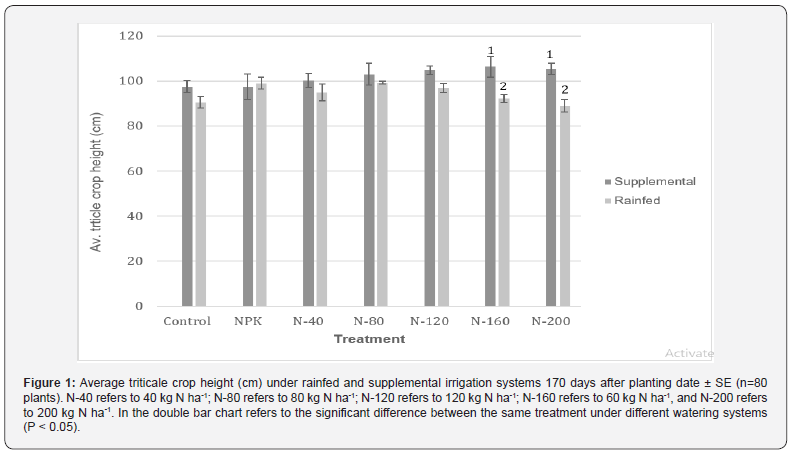
Supplementary irrigation alone or combined with nitrogen fertilizer at all rates significantly increased grain weight (Figure 4) and thousand-grain weight of triticale in comparison to all treatments under rainfed conditions (Figure 5). Supplementary irrigation alone was the most effective treatment in increasing the grain yield. The grain weight under both supplemental irrigation and rainfed conditions, excluding the nitrogen treatments, was 5816.33 kg/ha and 4914.29 kg/ha, respectively. Barati et al. [8] found that supplementary irrigation was the most influential factor affecting cereals’ grain weight. Nitrogen had no effect on the grain weight under rain feed system [9]. The reason for decreasing the grain weight under rainfed compared to supplemental irrigation systems could be due to drought stress and high temperatures during the grain-filling period, as it generally appears under Mediterranean conditions [10]. Regarding the nitrogen requirement of triticale, triticale needs below the average nitrogen fertilizer than other cereal grains [11]. Therefore, overfertilizing with nitrogen could lead to root growth and exudation impairment [12-14]. Our results are consistent with these studies because both adjacent fields of this experiment were planted with lentils in 2019. In other words, both adjacent experiments were already rich in nitrogen.
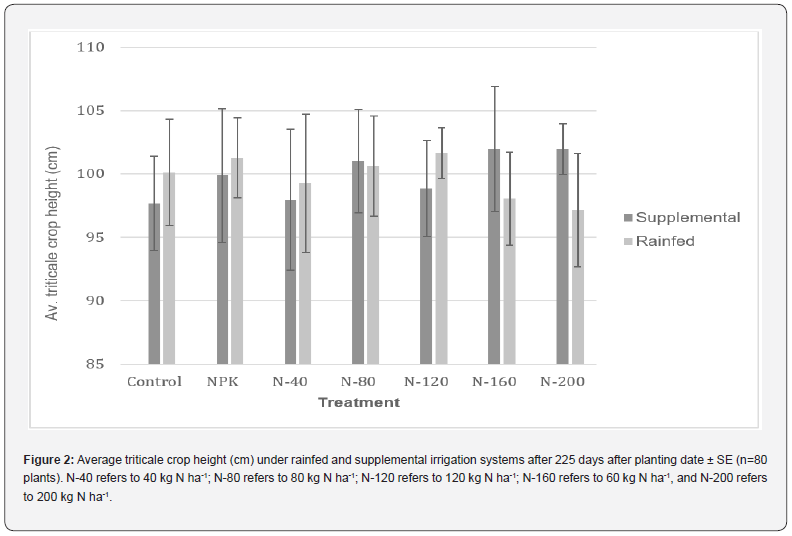
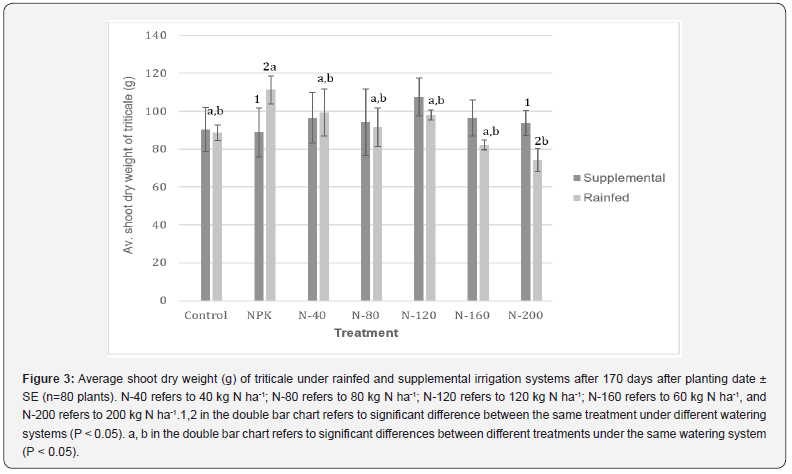
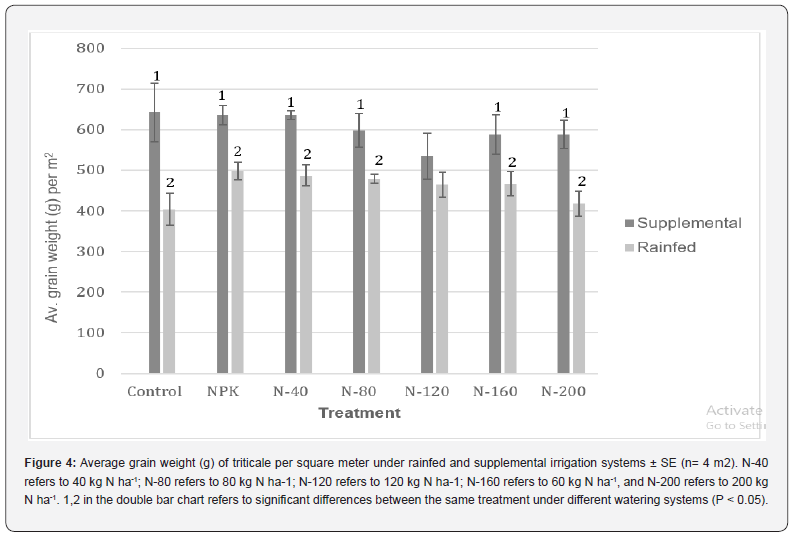
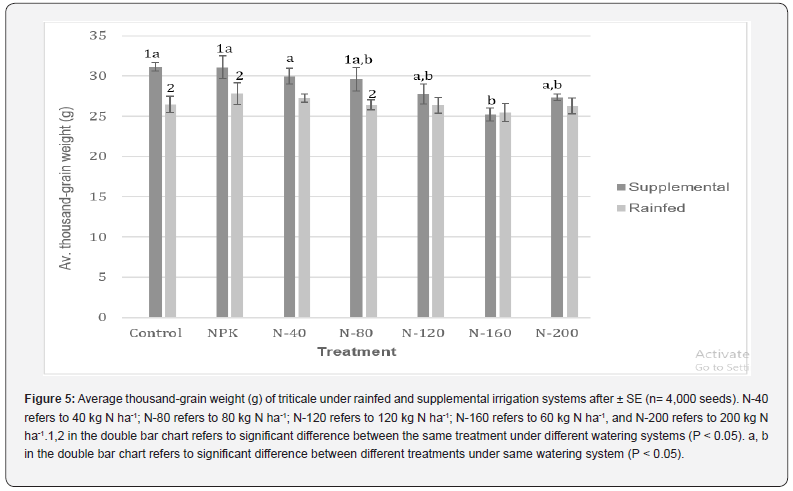
Grain protein content was higher in rainfed than in the supplementary irrigation (Figure 6). In general, most treatments under rainfed conditions recorded a higher protein content ratio than the same treatments under supplemental irrigation conditions. Addition of nitrogen at all tested rates did not enhance the grain protein content under rainfed conditions while they did under supplementary irrigation compared to their respective controls (Figure 5). Nitrogen at 160 kg/ha was the most effective treatment in increasing the grain protein content under supplementary irrigation in comparison to the control (Figure 6). It is interesting to note that unlike protein, the grain starch content was higher in supplementary irrigation than rainfed. Nitrogen at all tested rates had no significant effect on grain starch under both systems (Figure 7). We believe that the reason for higher protein content under rainfed for most treatments than the same under supplemental irrigation could be associated with the influence of water stress on the crop, which could activate the movement of nitrogen from the leaves to the grains, resulting in a boost in protein content in the grains [15,16]. Conversely, decreasing grain starch content in a drought situation is considered an obvious signal regarding the impact of drought on grain yield [17]. Studies by Flagella et al. [18] indicated that low grain starch content may lead to a negative effect on photosynthesis and thus reduce grain yield.
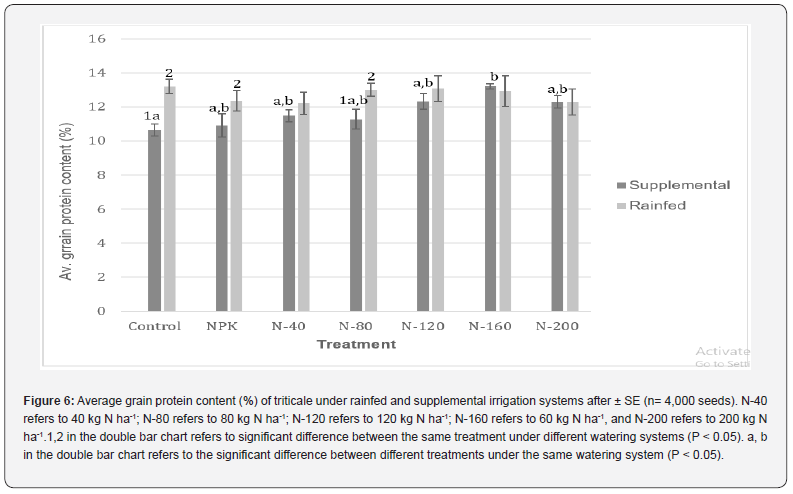
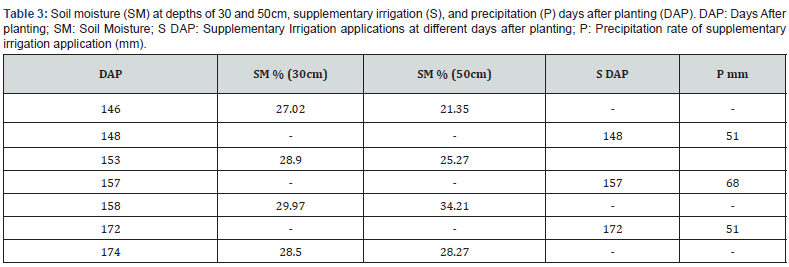
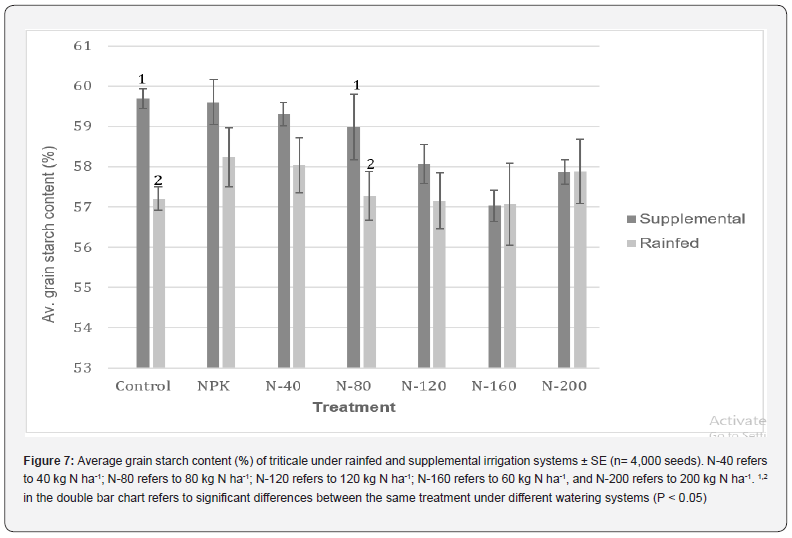
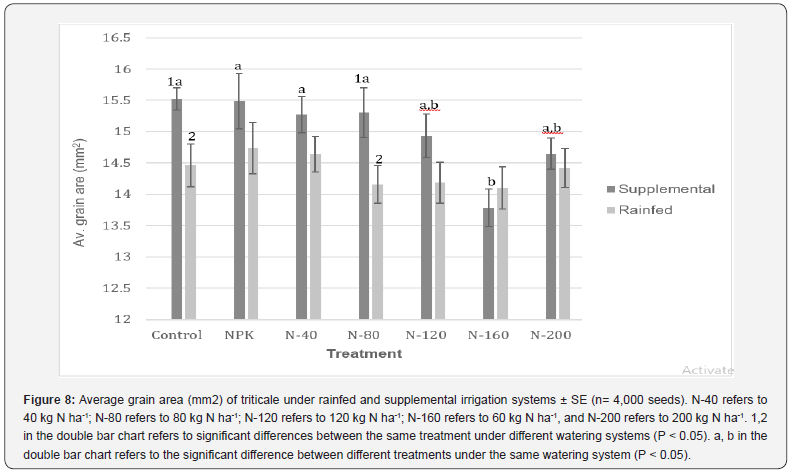
Nitrogen at all tested rates had no significant effect on grain area of triticale in comparison to the control under both irrigation systems (Figure 8). However, supplementary irrigation alone significantly increased the grain area in comparison to the rain fed condition. Our results show that morphological measurements of supplementary irrigation alone or with nitrogen were higher than under rainfed conditions. Previous studies indicated that grain size increased when the crops were irrigated compared to the same crops planted under rain fed conditions. Qi-hua et al. [19] showed that grain area, and grain perimeter of rice were significantly improved under irrigation system. Regarding the impact of nitrogen treatments on the grain morphological traits, results show that nitrogen did not increase the average of morphological grain traits in comparison to the control under supplemental irrigation.
Conclusion
Our results revealed that addition of nitrogen at various tested rates had no significant effect on grain yield on various growth parameters under supplementary and/or rainfed systems. There is a possibility that the soil is already rich with nitrogen or overfertilized and thus nitrogen had no significant effect on growth parameters. Besides, the land of the experiment was planted with lentils the year before this study. This may cause an increase in the nitrogen level in the soil. Yet, supplementary irrigation alone was the most influential factor on triticale growth and yield quantity and quality compared to rainfed. This factor can pose a significant risk to triticale producers when it is not monitored and managed correctly, and thus sequential supplemental irrigation is highly recommended.
Acknowledgment
The authors thank the agronomy staff of the Advancing Research Enabling Communities Center (AREC) at the American University of Beirut. They supplied our research with all the necessary facilities and offered plenty of attention and time. Besides, the assistance provided by Dr. Housam Shaib during lab work at AUB was greatly appreciated.
References
- Gupta PK, Priyadarshan PM (1982) Triticale: Present Status and Future Prospects. In Advances in Genetics 21: 255-345.
- Naeem HA, Darvey NL, Gras PW, MacRitchie F (2002) Mixing Properties, Baking Potential, and Functionality Changes in Storage Proteins During Dough Development of Triticale‐Wheat Flour Blends. Cereal chemistry 79(3): 332-339.
- FAO (2019) Major triticale growing countries in the world.
- Bashour II, Sayegh AH (2007) Methods of analysis for soils of arid and semi-arid regions. FAO.
- Martyniak L (2008) Response of spring cereals to a deficit of atmospheric precipitation in the particular stages of plant growth and development. Agricultural Water Management 95(3): 171-178.
- Bashour II (2001) Fertility and fertilizer requirements. Rural Integrated Development of the Mountains of Northern Lebanon. FAO Report to Ministry of Agriculture, Beirut, Lebanon, 116.
- Alagoz SM, Hadi H, Toorchi M, Pawłowski TA, Shishavan MT (2021) Effects of Water Deficiency at Different Phenological Stages on Oxidative Defense, Ionic Content, and Yield of Triticale (× Triticosecale Wittmack) Irrigated with Saline Water. J Soil Sci Plant Nutrition 22: 99-111.
- Barati V, Bijanzadeh E, Zinati Z (2020) Nitrogen source and deficit irrigation influence on yield and nitrogen translocation of triticale in an arid mediterranean agroecosystem. J Agri Sci Tech 22(5): 1295-1311.
- Zhang K, Wang J, Zhang L, Rong C, Zhao F, et al. (2013) Association Analysis of Genomic Loci Important for Grain Weight Control in Elite Common Wheat Varieties Cultivated with Variable Water and Fertiliser Supply. Plos One 8(3): e57853.
- Oweis T, Zhang H, Pala M (2000) Water use efficiency of rainfed and irrigated bread wheat in a Mediterranean environment. Agronomy J 92(2): 231-238.
- Defra A (2010) Fertiliser manual (RB209). Department of the Environment, Food and Rural Affairs, TSO (The Stationary Office), London.
- Deng Y, Chen K, Teng W, Zhan A, Tong Y, et al. (2014) Is the inherent potential of maize roots efficient for soil phosphorus acquisition? Plos One 9(3):e90287.
- Shen J, Li C, Mi G, Li L, Yuan L, et al. (2013) Maximizing root/rhizosphere efficiency to improve crop productivity and nutrient use efficiency in intensive agriculture of China. J Exp Bot 64(5):1181-1192.
- Teng W, Deng Y, Chen X-P, Xu X-F, Chen RW (2013) Characterization of root response to phosphorus supply from morphology to gene analysis in field-grown wheat. J Exp Bot 64(5): 1403-1411.
- Pourghasemian N, Moradi R, Naghizadeh M, Landberg T (2020) Mitigating drought stress in sesame by foliar application of salicylic acid, beeswax waste and licorice extract. Agricultural Water Management 231: 105997.
- Souza EJ, Martin JM, Guttieri MJ, O'Brien KM, Habernicht DK, et al. (2004) Influence of genotype, environment, and nitrogen management on spring wheat quality. Crop Sci 44(2): 425-432.
- Thitisaksakul M, Jiménez RC, Arias MC, Beckles DM (2012) Effects of environmental factors on cereal starch biosynthesis and composition. J Cereal Sci 56(1): 67-80.
- Flagella Z, Giuliani MM, Giuzio L, Volpi C, Masci S (2010) Influence of water deficit on durum wheat storage protein composition and technological quality. Eur J Agronomy 33(3): 197-207.
- Qi-hua LIU, Xiu WU, Bo-cong C, Cai-yun XIN, Feng C, et al. (2014) Effects of different irrigation methods on grain quality of japonica rice in Huanghuai District of China. Yingyong Shengtai Xuebao 25(9).






























